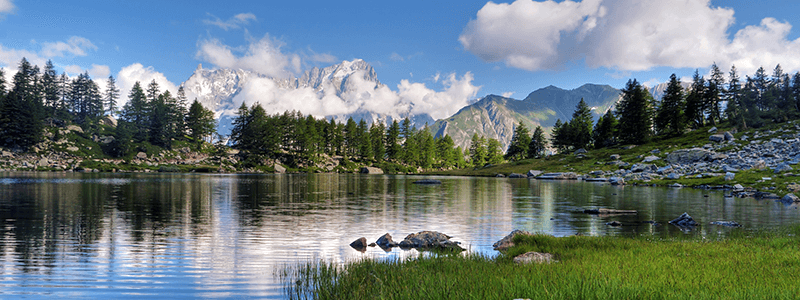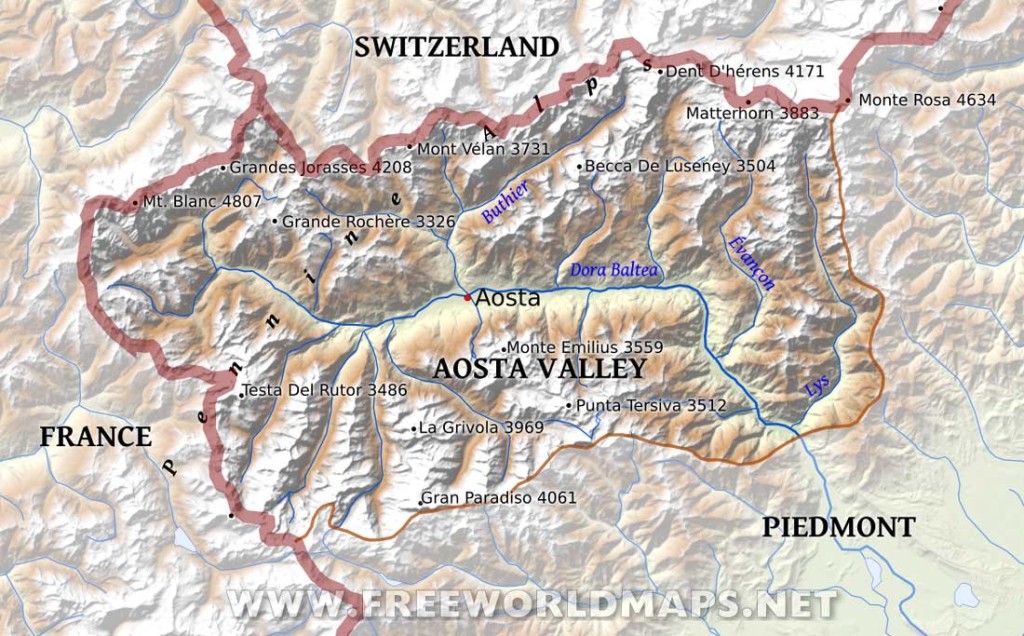
The Region of Valle d’Aosta (Aosta Valley) is Italy’s smallest and least populated region, yet it boasts some of Europe’s most dramatic landscapes. Nestled in the northwestern corner of Italy, it is surrounded by the towering peaks of Mont Blanc, the Matterhorn, and Monte Rosa, making it a paradise for skiers, hikers, and nature lovers.
With French and Italian bilingualism, Swiss-like villages, and medieval castles dotting its valleys, Valle d’Aosta is a unique blend of cultures and traditions. Whether you’re looking for world-class skiing, breathtaking hikes, or historic sites, this alpine region has something for everyone.
A Unique History and Cultural Identity
A Region of Many Influences
Unlike any other part of Italy, Valle d’Aosta has a distinct cultural identity shaped by French, Swiss, and Italian influences:
- Ancient Roman Roots – The Romans founded Augusta Praetoria (modern-day Aosta) in 25 BC, leaving behind amphitheaters, bridges, and city walls.
- Medieval Castles & Feudal Lords – The Challant family ruled the region for seven centuries, building the fairy-tale castles that still stand today.
- Bilingual Heritage – French and Italian are both official languages, while some valleys still speak a German-based dialect called Walser.
- Autonomy & Self-Governance – Valle d’Aosta enjoys special autonomy within Italy, allowing it to preserve its traditions and manage its own economy.
This cultural mix gives the region a distinct character, more reminiscent of Switzerland or France than the rest of Italy.
Top Cities and Towns to Visit in Valle d’Aosta
Aosta – The Alpine Capital with Roman Roots
Aosta, the regional capital, is a charming town filled with Roman ruins, medieval streets, and stunning mountain views.
Must-See Attractions:
- Arch of Augustus – A massive Roman triumphal arch, built in 25 BC.
- Teatro Romano – The remains of a Roman theater, once seating 4,000 spectators.
- Porta Praetoria – The ancient gateway to the city, remarkably well-preserved.
- Sant’Orso Complex – A medieval church and cloister with frescoes dating back to the 11th century.
Courmayeur – The Jewel of Mont Blanc
Courmayeur is one of Italy’s most famous ski resorts, offering luxury, charm, and adventure.
Top Attractions:
- Skyway Monte Bianco – A rotating cable car that takes you to the top of Mont Blanc, offering spectacular 360-degree views.
- Val Ferret – A breathtaking valley, perfect for hiking, cross-country skiing, and photography.
- Via Roma – A chic shopping street lined with boutiques, cafés, and restaurants.
Cogne – The Gateway to Gran Paradiso National Park
Cogne is the perfect base for exploring Gran Paradiso National Park, Italy’s oldest national park.
Best Things to Do:
- Lillaz Waterfalls – A stunning cascade surrounded by alpine meadows.
- Hiking & Wildlife Watching – Spot ibex, chamois, and eagles in the park.
Breuil-Cervinia – Skiing at the Foot of the Matterhorn
Breuil-Cervinia is one of Italy’s top ski resorts, connected to Zermatt in Switzerland.
Highlights:
- Matterhorn Glacier Paradise – Skiing year-round on Europe’s highest glacier.
- Lago Blu – A small alpine lake that reflects the Matterhorn on clear days.
Étroubles & La Thuile – Charming Alpine Villages
- Étroubles – A beautiful medieval village, known for its stone houses and mountain charm.
- La Thuile – A peaceful resort town with skiing, hiking, and thermal spas.
The Castles of Valle d’Aosta: A Journey Through Medieval History
Valle d’Aosta is famous for its medieval castles, built to defend the region’s strategic valleys.
Must-Visit Castles:
- Fénis Castle – The most picturesque medieval fortress in the region.
- Bard Fortress – A massive stronghold, now housing the Museum of the Alps.
- Issogne Castle – Features stunning Renaissance frescoes and a beautiful courtyard.
- Sarriod de la Tour Castle – Known for its mysterious “Room of the Heads” with carved wooden faces.
Outdoor Adventures in Valle d’Aosta
World-Class Skiing & Snowboarding
- Courmayeur & La Thuile – Perfect for luxury skiing.
- Breuil-Cervinia – Offers skiing into Switzerland.
- Pila – A family-friendly ski resort with amazing views of Mont Blanc.
Hiking & Trekking in the Alps
- Gran Paradiso National Park – Home to Italy’s only native ibex population.
- Tour du Mont Blanc – One of the most famous long-distance hiking trails in the world.
- Monte Rosa Massif – Stunning glacial hikes and mountaineering opportunities.
Summer Activities: Cycling, Climbing, and Rafting
- Cycling the Great St. Bernard Pass – A legendary Tour de France route.
- Rock Climbing in Cogne & Valtournenche – Ideal for climbing enthusiasts.
- Whitewater Rafting on the Dora Baltea River – One of Italy’s best rafting destinations.
Valle d’Aosta’s Food & Wine: Alpine Flavors and Hearty Dishes
Must-Try Dishes in Valle d’Aosta
- Fonduta Valdostana – A creamy cheese fondue, made with Fontina cheese.
- Carbonade – A hearty beef stew cooked in red wine.
- Polenta concia – Polenta with melted cheese and butter.
- Mocetta – A delicious cured meat, similar to prosciutto.
Valle d’Aosta’s Best Wines
- Petit Rouge – A rich, local red wine.
- Blanc de Morgex et de La Salle – A high-altitude white wine, perfect for seafood.
Getting Around Valle d’Aosta
Public Transport
- Trains – Connect Aosta to Turin, but do not reach remote valleys.
- Buses – Serve mountain villages and ski resorts, though they can be infrequent.
Best Way to Explore?
A rental car is recommended for exploring castles, national parks, and alpine passes.
Why Visit the Region of Valle d’Aosta?
Valle d’Aosta is a paradise for adventure, history, and nature lovers:
✅ Breathtaking alpine landscapes
✅ Charming medieval villages and castles
✅ World-class skiing and hiking
✅ Unique blend of French and Italian culture
Whether you’re skiing in Cervinia, hiking in Gran Paradiso, or exploring Aosta’s Roman ruins, Valle d’Aosta is an unforgettable destination for those seeking adventure and beauty.

